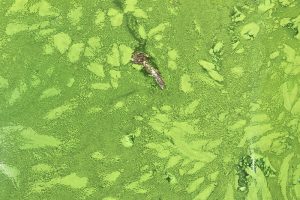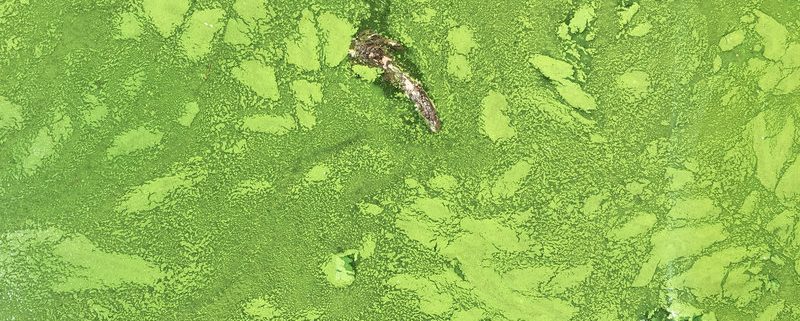A Contaminating Diversification: Discovering New Algal Toxins in Our Oceans and its Negative Implications
By Casey Dresbach, SRC intern
Coastal waters are one of the world’s greatest assets, yet they are being hit with pollution from all directions (U.S. Commission on Ocean Policy, 2004). As we move further into the Anthropocene, water conditions worldwide are continuing to degrade. The U.S. Environmental Protection Agency’s (EPA’s) 2002 National Water Quality Inventory found that just over half of the estuarine areas assessed were polluted to the extent that their use was compromised (U.S. Commission on Ocean Policy, 2004). Urban wastewater treatment plants, storm runoff, agricultural runoff, and animal feeding operations, are just some of the many sources in which our waters are faced with anthropogenic pollutants (See Figure 1). Eutrophication is the process by which water bodies are made more eutrophic through an increase in their nutrient supply (Smith, Tilman, & Nekola, 1999). Not only does this process cause damage on an ecological level, but it can have implications on economic impacts as well (U.S. Commission on Ocean Policy, 2004). Some of which include beach closures and severe increases in health care costs. It is the leading pollution problem that both humans and animals are facing.

Toxin Microcystin in the blue-green algae in Discovery Bay, California. Human exposure to such toxin may include dizziness, rashes, fever and vomiting.) (McClurg/KQED, 2016).
In a recent study, the San Francisco Bay (SFB) was analyzed on behalf of its responsibility for Harmful Algal Blooms (HABs) in its eutrophic estuary (Peacock, Gibble, Senn, Cloern, & Kudela, 2018). As mentioned earlier, eutrophication as a result of human induced nutrient inputs from growing urban lifestyles are increasing the frequencies of HABs. This study looked into the presence of four harmful algal toxins present in SFB’s specifically within the marine mussel, Mytilus californianus. The toxins found came from both marine and freshwater sources, an alarming discovery. “The bay is acting as a big mixing bowl where toxins from both fresh and marine water are found together,” said senior author Raphael Kudela, the Lynn Professor of Ocean Health at UC Santa Cruz. “A big concern is that we don’t know what happens if someone is exposed to multiple toxins at the same time.” (Peacock, Gibble, Senn, Cloern, & Kudela, 2018).
The four toxins found were Domoic acid, Saxitoxins, Dinophysis, and Microcystin. Domoic acid is a neurotoxin that causes amnesic shellfish poisoning in humans and is produced by marine diatoms. Saxitoxins are paralytic and primarily found in shellfish. Dinophysis are also shellfish toxins that cause severe diarrhetic poisoning. Microcystins are produced by freshwater cyanobacteria and can cause liver damage in both humans and animals. (Peacock, M. B., Gibble, C. M., Senn, D. B., Cloern, J. E., Kudela, R. M., 2018). The study was also conducted during a severe drought in California, which could have brought some of these marine toxins further into the bay due to less freshwater river flow.

NASA uses airborne remote imaging spectrometer to create maps of San Francisco Bay showing water clarity (turbidity), dissolved carbon, and Chlorophyll-a. as indicators of water quality). (NASA/Jet Propulsion Laboratory, 2016).
The presence of the toxins indicated that both the mussels and humans who consume them are exposed to poisoning at both sub-lethal and acute levels. The findings showed that 99% of the mussels collected from SFB were contaminated with one of the listed toxins and 37% had all four. Although alarming, the results served as a progressive measure towards changes and monitoring programs within several federal agencies (Peacock, Gibble, Senn, Cloern, & Kudela, 2018). The other important variable, the drought environment in which this study was conducted, is also important to consider. NASA recently published a study on behalf of their monitoring of SFB’s quality of freshwater (NASA/Jet Propulsion Laboratory, 2016). They demonstrated how an airborne environmental monitoring instrument could be useful in helping monitor not only estuarine waters native to California, but coastal waters worldwide (See Figure 2).
When studies such as these are published, it is dire for the public to grasp the central purpose of such examinations especially in the cases of eutrophication, which affect both humans and animals worldwide. Unfortunately, harmful algal blooms are assuming a more normative nature and its long-term implications absorbed by both humans and animals are not entirely understood. More research needs to be done in this sector specifically, especially when dealing with lethal and sub-lethal levels of toxins within our communities worldwide. The findings also suggest the need to better monitor both marine and freshwaters, similar to what NASA did with their study in the estuary of SFB (NASA/Jet Propulsion Laboratory, 2016).
Overall, deeper analyses should be performed in collaborative measures to incorporate a sense of inclusivity from both the public and scientific sector. Published science is readily available, however it is the proper dissemination of knowledge to human populations outside of the scientific community that is lacking. Without a fertile middle ground to interpret the specificity of what is going on in a world threatened by pollution, policy work, legal intervention, and preventative measures will be challenging to attain. Reducing water pollution will alleviate a series of pressures on both an ecological and economic scale. Cleaner coastal waters and healthy habitats for aquatic life should continue to be the primary concern for policy makers in modern marine affairs.
Works Cited
McClurg/KQED, L. (2016, August 29). Poisonous Algae Blooms Threaten People, Ecosystems Across U.S.
NASA/Jet Propulsion Laboratory . (2016, February 29). NASA demonstrates airborne water quality sensor.
Peacock, M. B., Gibble, C. M., Senn, D. B., Cloern, J. E., & Kudela, R. M. (2018). Blurred lines: Multiple freshwater and marine algal toxins at the land-sea interface of San Francisco Bay, California. Harmful Algae , 73, 138-147.
Smith, V. H., Tilman, G. D., & Nekola, J. C. (1999, March 22). Eutrophication: impacts of excess nutrient inputs on freshwater, marine, and terrestrial ecosystems. Environmental Pollution.
U.S. Commission on Ocean Policy. (2004). An Ocean Blueprint for the 21st Century Chapter 14: Addressing Coastal Water Pollution. Washington: University Press of the Pacific.




Leave a Reply
Want to join the discussion?Feel free to contribute!